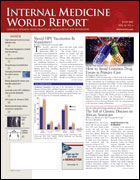Publication
Article
Internal Medicine World Report
New Mammography Screening Guidelines for Women in Their 40s
Author(s):
FROM THE AMERICAN COLLEGE OF PHYSICIANS
Ann Intern Med
The new clinical guidelines for screening mammography in women aged 40 to 49 years (Table) from the American College of Physicians (ACP) emphasize the need for careful assessment of individual risk factors to help guide the decisions about mammography (. 2007;146:511-526).
According to the guidelines' authors, breast cancer risk is unevenly distributed in younger women, and thus the benefits of screening mammography are not uniformly applicable in this age-group.
"It is important to tailor the decision of screening mammography by discussing the benefits and risks with a woman, addressing her concerns, and making it a joint decision between her and her physician," said the ACP's Amir Qaseem, MD, PhD, lead author of the guidelines.
The guidelines are based on an analysis of 117 systematic reviews, observational studies, and randomized controlled trials designed to assess the effect of mammography screening on breast cancer mortality, the cumulative risk for a false-positive result, and other risks of mammography.
Screening mammography every 1 to 2 years in women aged 40 to 49 years was found to result in a 15% decrease in breast cancer mortality after 14 years of follow-up. This survival benefit is smaller than the 22% mortality reduction observed in women aged ≥50 years.
Women with breast cancer detected by screening mammography are considered more likely to be eligible for breast-conserving surgery and less likely to receive adjuvant chemotherapy and hormone therapy than women whose breast cancer is detected in other ways.
Mammography screening is associated with absolute increases in the probabilities of mastectomy, lumpectomy, and radiation therapy, because more cases of cancer are detected.
Rates of false-positive results from screening mammography are high, ranging from 21% to 56% after 10 mammograms for all women. False-positive results have been linked to small increases in generalized anxiety and depression, but they do not decrease the likelihood of subsequent screening mammography.
The variability in the risks and benefits of screening mammography has particular clinical relevance in women under 50, since their lower rates of disease underscore the importance of individual risk factor assessment, including age, family history, and breast density.
Table. Recommendations for screening mammography for women aged 40-49
Physicians should:
• Periodically perform individualized assessments of the risk for breast cancer to help guide decisions about screening mammography
• Inform women about the potential benefits and harms of screening mammography
• Base screening mammography decisions on the benefits and harms of screening, as well as on a woman's preferences and breast cancer risk profile
Ann Intern Med
Sources: Qaseem A, Snow V, Sherif K. Screening mammography for women 40 to 49 years of age: a clinical practice guideline from the American College of Physicians. . 2007;146:511-526.
Age is one of the most frequently used criteria for assessing breast cancer risk. The 5-year risk of breast cancer is 0.28% in 35-year-old women versus 2.35% in 75-year-old women.
Having a first-degree relative with breast cancer increases a woman's risk by 2- to 3-fold. Among women aged 40 to 49 years, the rate of breast cancer detection per 1000 mammograms increases from 2.7 among those without a family history of breast cancer to 4.7 among those with a positive family history.
Breast density has a significant impact on the sensitivity and specificity of screening mammography. Sensitivity increases from 62% in women whose breasts are extremely dense to 88% in those whose breasts are almost entirely fat; the false-positive rate is 4.2% and 9.7% in these 2 groups, respectively.
The risk for cancer caused by radiation exposure from mammography screening is considered low, based on studies of other forms of radiation exposure. Reports on the prevalence of pain and discomfort during mammography vary widely (up to 77%). The likelihood of pain appears to be related to anxiety, anticipation of pain, and menstrual cycle.
The guidelines provide a link to a tool for making a quantitative estimate of the risk of invasive breast cancer, based on the Gail model and provided by the National Institutes of Health, which can be found at bcra.nci.nih.gov/brc/q1.htm.






